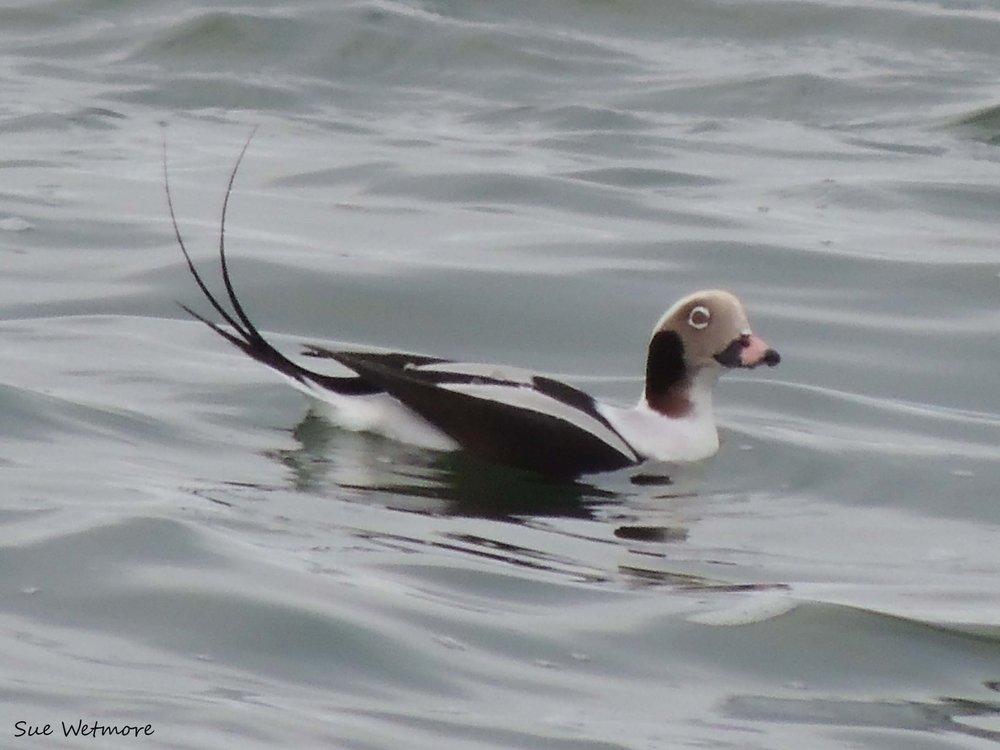 SanderlingsMid-November is one of the best times to head to the New England coast in search of winter migrants. Cape Ann, Plum Island and the nearby beaches are areas that migrants frequent in their flight south. Other species will find these areas perfect for a wintering spot. I recently visited there with friends.
SanderlingsMid-November is one of the best times to head to the New England coast in search of winter migrants. Cape Ann, Plum Island and the nearby beaches are areas that migrants frequent in their flight south. Other species will find these areas perfect for a wintering spot. I recently visited there with friends.
Cape Ann juts out into the Atlantic Ocean, giving the birder an opportunity to view a variety of ocean birds. Halibut Point is a high bluff that has a dramatic view of the ocean below which gives the observer a great chance of seeing these migrants as they pass by.
Our group had hoped for some alcids to be moving through, but it was not to be. However, the appearance of a flock of harlequin ducks made up for that. We watched as these sturdy creatures dove into the surf right by the granite rocks. We also saw gulls and gannets as well as other waterfowl.
After spending an hour and a half there we packed up and headed to Gloucester Harbor. There we saw common eider, red-breasted merganser, bufflehead and a common loon. A flock of snow buntings circled over us several times before landing on some rocks just feet away from us! Their soft calls and beautiful plumage made for a magical close-up view.
The next day we traveled to Plum Island and the Parker River National Wildlife Refuge. This area provides 4,700 acres of pristine coastal habitat. This includes 3,000 acres of salt marshes that has seen 300 plus species of birds that are either residents or migratory. In addition, this refuge has critical nesting habitat for the endangered piping plover. With six miles of beach there are many chances to observe a nice variety of ocean and coastal birds. There are hiking trails that travel through dunes, marshes and coastal scrub allowing the birder to find inland birds in proper season.
 Long-tailed DuckDriving down the park road offers easy access to the salt marshes and ample opportunity to observe shorebirds and waterfowl. Our plan was to start at the north end of this island. As we drove along, there on a fence sat a Cooper's hawk, intently watching some terrified house sparrows.
Long-tailed DuckDriving down the park road offers easy access to the salt marshes and ample opportunity to observe shorebirds and waterfowl. Our plan was to start at the north end of this island. As we drove along, there on a fence sat a Cooper's hawk, intently watching some terrified house sparrows.
Continuing on we arrived at the parking area and made our way to the beach. Here we had a great view of the channel with a strong tide running. Harbor seals were popping up and looking around as red-throated and common loons dove for a meal.
One surfaced with a wiggly silver fish for its effort. An eBird notice told of a Pacific loon there and, in no time, one of our group spotted this bird. It was in transitional plumage, but the distinctive head shape was the clincher.
We returned to the park road and headed south along the salt marshes where black-bellied plovers and dunlin were resting. American black ducks were the most abundant waterfowl. Others there included hooded merganser and bufflehead. And, of course, mallards. A sharp-shinned hawk rocketed by in front of our car in pursuit of something as we made our way along the road.
We stopped at a view point overlooking a pond where three gadwall sedately paddled about the water. Off in the distance a bald eagle sat on a rise of land while overhead a rough-legged hawk hovered in search of food.
Continuing on I spied a northern shrike perched atop a distant tree.
We then parked at one of the beach access paths and scanned the ocean finding more loons, red-necked grebes, a variety of gulls and a lovely flock of sanderlings that twittered as they probed the sand. Northern gannets were seen gliding over the ocean with their startling white plumage.
All too soon our coastal adventure was coming to an end. However, before departing I checked eBird once again and saw that a king eider was being seen at Crane Beach. Fortunately, this spot was on my way home and only half an hour from Rockport.
I soon arrived there and set up my scope to scan over 1,000 white-winged scoters in hopes of finding this beautiful duck. Luck was with me and in less than five minutes I was watching the bird.
As I walked down the beach semipalmated plovers scurried along. I then met two young women, birders and photographers, who told me they had just seen a snowy owl about a half mile down the beach. Wasting no time I quickly made my way there following their footsteps in hopes of finding the bird. As I got nearer I saw a person staring intently through binoculars. I set up my scope and scanned that area and there it was. I made my way closer to this bird which seemed totally unconcerned with the people that were delighted to have this visitor from the north. The owl sat and posed for numerous photos putting a perfect end to the coastal birding trip.